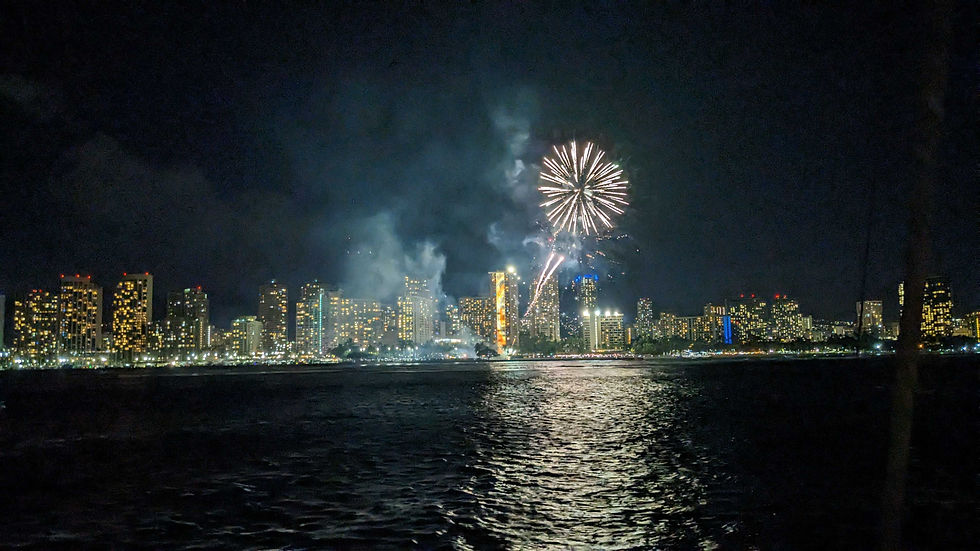Whale‑Watching Season in Waikiki: When to See Humpbacks Up Close
- oahuoceanadventure
- Nov 9
- 3 min read

The Epic Journey to Hawaii
Every fall, thousands of North Pacific humpback whales embark on one of the longest migrations of any mammal. They swim over 3,000 miles from Alaska and Canada to Hawaii, a journey that takes about four to six weeks. Whales make the trip without feeding; instead, they build up blubber reserves by eating up to 3,000 pounds of krill, herring and small fish per day in their northern feeding grounds. Once they arrive in Hawaii, they use those fat stores to sustain themselves while they mate, give birth and nurse their calves.
Scientists believe humpbacks navigate using the Earth’s magnetic fields, seafloor landmarks and even inherited “maps” passed down through songs. Whatever the method, they consistently return to Hawaii’s warm, shallow waters, an ideal nursery where newborn calves, born with little blubber, can stay warm and protected. The channels between the islands offer calm waters where mothers can rest and teach their calves to swim, and the lack of predators like orcas makes Hawaii one of the safest places for humpback babies. In Hawaiian culture whales, or koholā, are considered guardians and symbols of strength, adding cultural significance to their annual return.
When to Go Whale Watching
Humpbacks begin arriving around mid‑November, with numbers increasing throughout December and peaking from January through March. Tours generally operate through April. Oahu Ocean Adventures offers whale‑watching trips from both the south shore near Waikiki and Oahu’s North Shore, ensuring there is always a convenient option. Each tour lasts about 2.5 hours, accommodates up to six guests and costs $89 per person. Because the boats are small, the crew can maneuver closer to whales while following federal guidelines for responsible viewing. Tours depart from Ala Wai Boat Harbor; parking costs $1 per hour.
What to Expect
During whale‑watching season you might see mothers with calves, acrobatic males breaching and slapping their tails, or pods of whales socializing near the surface. Reviewers rave about seeing whales logging (resting), breaching and even hearing their songs via hydrophone. Oahu Ocean Adventures’ experienced crew provides educational commentary about whale biology, behavior and cultural significance. Because tours are small, you have plenty of room to move around for better views and to ask questions. Many guests also spot spinner dolphins, flying fish, sea turtles and monk seals on the way to the whales.
Responsible Whale Watching
Oahu Ocean Adventures follows best practices for responsible wildlife viewing. Boats approach whales slowly and maintain legal distances to avoid disturbing them. The crew emphasizes respect for animals and the ocean environment. Guests are asked to apply reef‑safe sunscreen, keep voices low near whales and avoid sudden movements. Because humpbacks do not feed in Hawaii, giving them space and minimizing stress helps ensure they have enough energy to nurse their calves and complete their migration back north.
Tips for an Unforgettable Tour
Book during peak months (January–March). More whales mean higher chances of spectacular breaches.
Choose a morning departure. Water conditions are often calmer early in the day.
Bring binoculars and a camera. Whale behavior can happen quickly, so be ready.
Dress in layers. It can be cool on the water even in Hawaii; a light jacket is useful.
Pack snacks and drinks. Oahu Ocean Adventures provides ice but you’ll appreciate water and light snacks.
A Once‑in‑a‑Lifetime Experience
Seeing humpback whales in the wild is humbling. Their sheer size, adults can reach up to 50 feet, combined with their gentle behavior makes for a powerful encounter. Add in the backdrop of Waikiki’s skyline or the North Shore’s cliffs and you have a scene you’ll never forget. By choosing a small‑group tour with knowledgeable guides, you’ll learn more and feel better knowing you’re supporting sustainable tourism. Whale‑watching season in Waikiki is short, so plan ahead and prepare to be amazed by the giants of the Pacific.




Comments